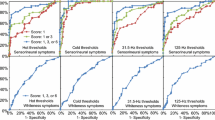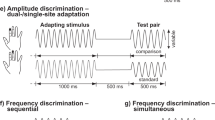Summary
Recognition of the fact that impairment of the tactile sense may occur independently of other disturbances in the vibration syndrome has rekindled an interest in developing a diagnostic method for early detection of vibration-induced neuropathy. There is also evidence suggesting that vibrotactile measurements represent a valuable diagnostic tool in compressive neuropathies, such as the carpal tunnel syndrome. The method may also become useful for diagnosing sensory neuropathies caused by other factors, such as solvents, pesticides, heavy metals, alcoholism, and diabetes. However, before vibrotactile measurement can be accepted and established as a tool for clinical diagnostic purposes, for screening, and in research, the level and the shape of the normal threshold curve have to be specified. With the purpose of assembling normative data, the vibrotactile perception thresholds (8–500 Hz) of the right index fingertip were measured in 171 healthy males (19–75 years) not exposed to vibration. A Békésy audiometer was modified to operate in combination with a vibration exciter, instead of headphones, at frequencies lower than usual (8–500 Hz). The results showed that the perception thresholds increased from about 100 dB to about 140 dB (rel. 10−6 m/s2rms) as a function of frequency and age. The frequency-dependent changes were not linear, however, but displayed a peak in sensitivity at 125 Hz. Threshold changes due to aging were most pronounced at the highest frequencies. It is of the utmost importance that these natural changes are taken into account when making comparisons between groups or individuals.
Similar content being viewed by others
References
Bdkdsy G von (1947) A new audiometer. Acta Otolaryngol (Stockh) 34:411–422
Bolanowski S, Gescheider G, Verrillo R, Checkosky C (1988) Four channels mediate the mechanical aspects of touch. J Acoust Soc Am 84:1680–1694
Bovenzi M, Fiorito A, Volpe C (1987) Bone and joint disorders in the upper extremities of chipping and grinding operators. Int Arch Occup Environ Health 59:189–198
Brammer A, Piercy J, Auger P (1987) Assessment of impaired tactile sensation: a pilol study. Scand J Work Environ Health 13:380–384
Brammer A, Taylor W, Lundborg G (1987) Sensorineural stages of the hand-arm vibration syndrome. Scand J Work Environ Health 13:279–283
Brammer AJ, Piercy JE (1990) Tactile sensation in vibration-exposed workers: quantitative assessment. In: Okada A, Taylor W, Dupuis H (eds) Hand-arm vibration. Kyoei, Kanazawa, Japan, pp 71–74
Brammer AJ, Taylor W, Piercy JE (1986) Assessing the severity of the neurological component of the hand-arm vibration syndrome. Scand J Work Environ Health 12:428–431
Ekenvall L, Nilsson B, Gustavsson P (1986) Temperature and vibration thresholds in vibration syndrome. Br J Ind Med 43:825–829
Fagius J, Wahren L-K (1981) Variability of sensory threshold determinations in clinical use. J Neurol Sci 51:11–27
Färkkilä M, Pyykkö I, Starck J, Korhonen O (1982) Hand grip force and muscle fatigue in the etiology of the vibration syndrome. In: Brammer A, Taylor W (eds) Vibration effects on the hand and arm in industry. John Wiley, New York, pp 45–50
Gemne G (1982) Pathophysiology and multifactorial etiology of acquired vasospastic disease (Raynaud syndrome) in vibration-exposed workers. Scand J Work Environ Health 8:243249
Gemne G, Saraste H (1987) Bone and joint pathology in workers using hand-held vibrating tools. Scand J Work Environ Health 13:290–300
Goff GD (1965) Vibration perception in normal man and medical patients. J Neurol Neurosurg Psychiatry 28:503–509
Goldberg JM, Lindblom U (1979) Standardized method of determining vibratory perception thresholds for diagnosis and screening in neurological investigation. J Neurol Neurosurg Psychiatry 42:793–803
Green BG (1977) The effects of skin temperature on vibrotactile sensitivity. Percept Psychophys 21:243–248
Gregersen G (1968) Vibratory perception threshold and motor conduction velocity in diabetes and non-diabetics. Acta Med Scand 183:61–65
Gregg EC (1951) Absolute measurement of the vibratory threshold. Arch Neurol Psychiatry 66:403–411
Hagberg M, Johansson RS, Zetterlund B (1985) Tactile perception in workers with vibration syndrome. Fourth Int Symp Hand-Arm Vibration (abstract). Helsinki, p 56
Halonen P (1986) Quantitative vibration perception thresholds in healthy subjects of working age. Eur J Appl Physiol 54:647–655
Jetzer T, MacLeod D, Conrad J, Troyer S, Jacobs P, Albin T (1990) The use of vibration testing to evaluate workers and tools. In: Okada A, Taylor W, Dupuis H (eds) Hand-arm vibration. Kyoei, Kanazawa, Japan, pp 79–82
Johansson R, Lundström U, Lundström R (1982) Responses of mechanoreceptive afferent units in the glabrous skin of the human hand to sinusoidal skin displacements. Brain Res 244:17–25
Johansson R, Vallbo Å (1983) Tactile sensory coding in the glabrous skin of the human hand. Trends Neurosci 6:27–32
Lamore P, Keemink C (1988) Evidence for different types of mechanoreceptors from measurements of the psychophysical threshold for vibrations under different stimulation conditions. J Acoust Soc Am 83:2339–2351
Lidström I-M, Hagelthorn G, Bjerker N (1982) Vibration perception in persons not previously exposed to local vibration and in vibration-exposed workers. In: Brammer AJ, Taylor W (eds) Vibration effects on the hand and arm in industry. John Wiley, New York, pp 59–66
Lundberg G, Lie-Stenström AK, Sollerman C, Pyykkö I, Strömberg T (1986) Digital vibrogram — a new diagnostic tool for sensory testing in compression neuropathy. J Hand Surg [Am] 11:693–699
Lundborg G, Sollerman C, Strömberg T, Pyykkö I, Rosén B (1987) A new principle for assessing vibrotactile sense in vibration-induced neuropathy. Scand J Work Environ Health 13:375–379
Lundström R (1984) Vibrotactile sensitivity of the human hand's glabrous skin. J Low Freq Noise Vibration 3:88–95
Lundström R (1985) Effects of local vibration transmitted from ultrasonic devices on vibrotactile perception in the hands of therapist. Ergonomics 28:793–803
Lundström R (1986) Responses of mechanoreceptive afferent units in the glabrous skin of the human hand to vibration. Scand J Work Environ Health 12:413–416
Lundström R (1990) Digital tactilogram as a diagnostic tool for early diagnosis of vibration-induced neuropathy. In: Okada A, Taylor W, Dupuis H (eds) Hand-arm vibration. Kyoei, Kanazawa, Japan, pp 75–77
Lundström R, Lindmark A (1982) Effects of local vibration on tactile perception in the hands of dentists. J Low Freq Noise Vibration 1:1–11
Lbfvenberg J, Johansson RS (1984) Regional differences and interindividual variability in sensitivity to vibration in the glabrous skin of the human hand. Brain Res 301:65–72
Nilsson T, Hagberg M, Burström L, Lundström R (1990) Prevalence and odds ratios of numbness and carpal tunnel like syndrome in different exposure categories of platers. In: Okada A, Taylor W, Durpuis H (eds) Hand-arm vibration. Kyoei, Kanazawa, Japan pp 235–240
IOSH (1989) Occupational exposure to hand-arm vibration. Criteria for a recommended standard. U.S. Department of Health and Human Services, DHHS (NIOSH) Publication No. 89–106
Pearson GHI (1928) Effects of age on vibratory sensibility. Arch Neurol Psychiatry 20:482–496
Pyykkö I, Hyvärinen J, Fdrkkilä M (1982) Studies of the etiological mechanism of the vasospastic component of the vibration syndrome. In: Brammer A, Taylor W (eds) Vibration effects on the hand and arm in industry. John Wiley, New York, pp 13–24
Taylor B (1989) Bad vibrations. New Scientist 14:41–47
Taylor W, Brammer A (1982) Vibration effects on the hand and arm in industry: an introduction and review. In: Brammer A, Taylor W (eds) Vibration effects on the hand and arm in industry. John Wiley, New York, pp 1–12
Verrillo R (1963) Effect of contactor area on the vibrotactile threshold. J Acoust Soc Am 35:1962–1966
Verrillo R (1979) Comparison of vibrotactile threshold and suprathreshold responses in men and women. Percept Psychophys 26:20–24
Verrillo R (1980) Age related changes in the sensitivity to vibration. J Gerontol 35:185–193
Verrillo R, Bolanowski SJ (1986) The effects of skin temperature on the psychophysical responses to vibration on glabrous and hairy skin. J Acoust Soc Am 80:528–532
Westling G, Johansson R (1984) Factors influencing the force control during precision grip. Exp Brain 53:277–284
Author information
Authors and Affiliations
Rights and permissions
About this article
Cite this article
Lundström, R., Strömberg, T. & Lundborg, G. Vibrotactile perception threshold measurements for diagnosis of sensory neuropathy. Int. Arch Occup Environ Heath 64, 201–207 (1992). https://doi.org/10.1007/BF00380910
Received:
Accepted:
Issue Date:
DOI: https://doi.org/10.1007/BF00380910




